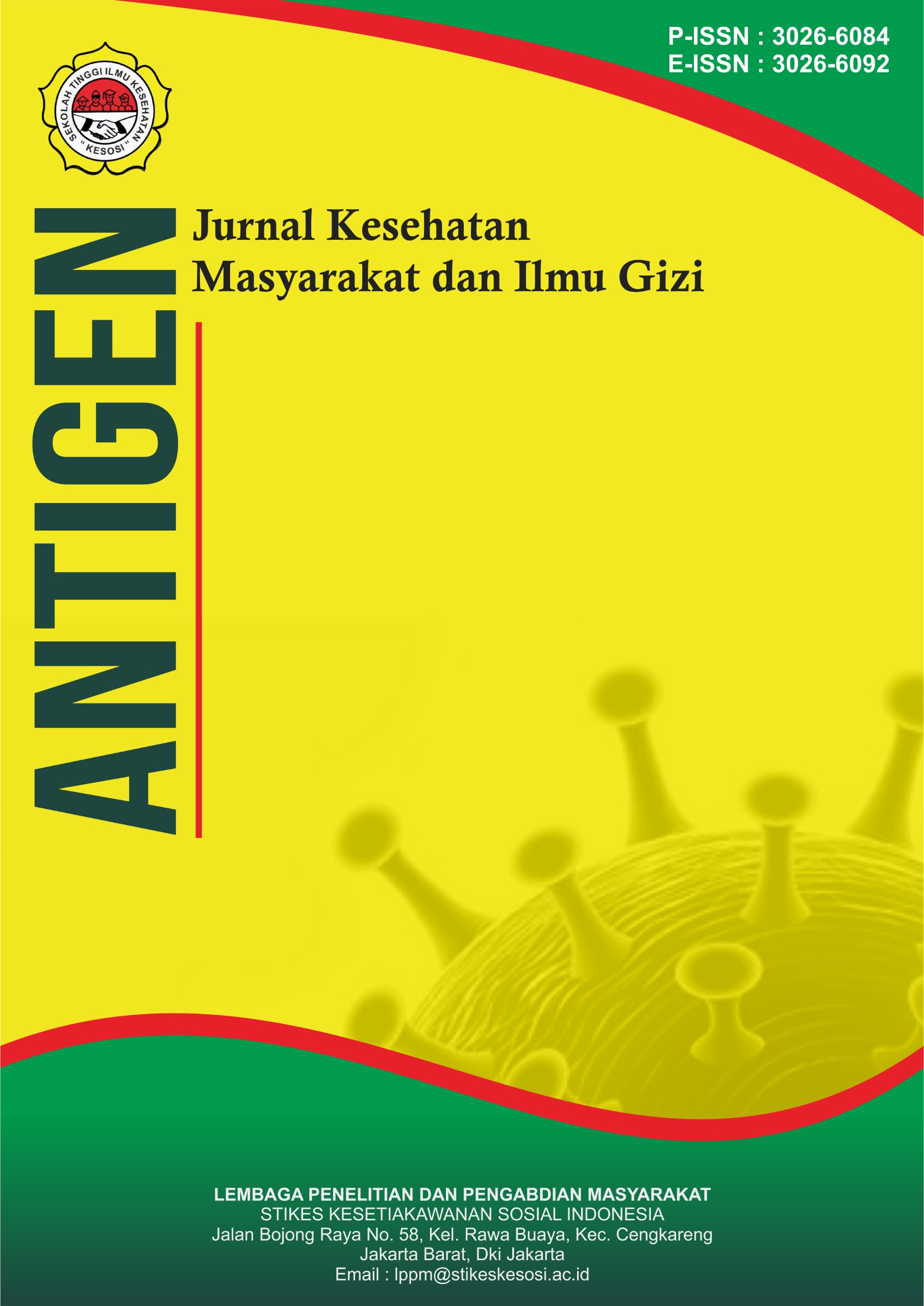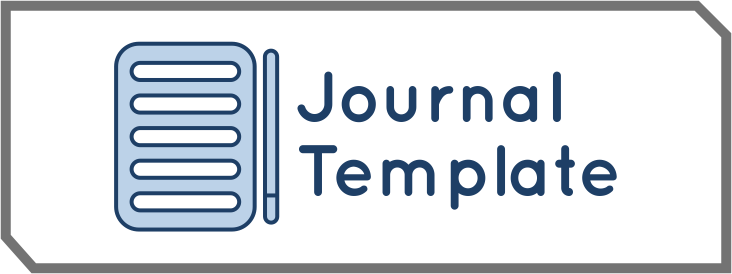Pengaruh Edukasi Gizi Terhadap Feeding Practice Ibu Balita Stunting Usia 6 – 59 Bulan di Wilayah Kerja Puskesmas Biaro Kabupaten Agam Tahun 2024
DOI:
https://doi.org/10.57213/antigen.v3i1.569Keywords:
Nutrition Education, Feeding Practice, Mother of Toddler, StuntingAbstract
Currently, the issue of stunting in toddlers remains quite high and can be triggered by poor feeding practices. According to the Biaro Health Center report in 2022, of the 3,036 toddlers, 172 (5.67%) were stunted. In 2023, from 3,096 toddlers, the number of stunted children increased to 227 (7.33%). The purpose of this study was to determine the effect of nutrition education on the feeding practices of mothers with stunted toddlers aged 6 – 59 months in the working area of Puskesmas Biaro, Agam Regency in 2024. This study is a pre-experimental research with a pretest-posttest one-group design. The research was conducted from August to December 2024 in the Biaro Health Center working area. The population of this study was all mothers of stunted toddlers aged 6 – 59 months in October 2024 in the Biaro Health Center working area, totaling 39 individuals, with a sample size of 16. Sampling was done using purposive sampling. Data were collected using questionnaires and analyzed with univariate and bivariate analysis using paired t-test. The results showed that the average feeding practice score of mothers with stunted toddlers aged 6 – 59 months before nutrition education was 35.0 with a standard deviation of 5.657, and after the education, it was 49.94 with a standard deviation of 4.864. The statistical test results indicated a significant effect of nutrition education on the feeding practices of mothers with stunted toddlers aged 6 – 59 months, with a p-value of 0.000 (p < 0.05). The conclusion is that nutrition education has an effect on the feeding practices of mothers with stunted toddlers aged 6 – 59 months. It is recommended that health workers provide routine nutrition education to improve the feeding practices of mothers with stunted toddlers.
References
Ahmad, Aripin, Suryana, Yulia Fitri. 2020. ASI Eksklusif Anemia dan Stunting pada Anak Baduta (6-24 bulan) Di Kecamatan Darul Imarah Kabupaten Aceh Besar. Jurnal Gizi Poltekkes Kemenkes Aceh: Aceh.
Achadi LA .2019. Seribu Hari Pertama Kehidupan Anak. Disampaikan pada Seminar Sehari dalam Rangka Hari Gizi Nasional ke 60. FKM UI, Maret 2020. Depok.
Agustina, Amanda. 2019. Pegaruh Edukasi Gizi Terhadap Feeding Practice ibu Stunting Pada Balita (24-59 Bulan) di Wilayah Kerja Puskesmas Sosial. Palembang.
Andrews, E., Kessler, J., & Knight, K. (2021). The role of maternal nutrition education in reducing childhood stunting: A systematic review. Nutrition and Health, 33(2), 123-135.
Booth, D. A. dan Booth, P. 2019. Targeting Cultural Changes Supportive of the Healthiest Lifestyle Pattern. A Biosocial Evidence-Base for Prevention of Obesity. Elsevier Ltd. 56(1): 210-221.
Cmes, G, E. et al. 2019. Eating Self-Efficacy: Development pf a Short-from WEL, Eating Behavior. Elsevier Ltd. 13(4): 375-378.
Fitri. 2019. Pegaruh Edukasi Gizi Terhadap Feeding Practice ibu Stunting Pada Balita Stunting Pada Balita (12-59 bulan) di Sumatera (Analisis Data Riskesdas 2020). Universitas Indonesia.
Ghina, M. 2019. evaluasi pelaksanaan program pencegahan stunting ditinjau dari intervensi gizi spesifik gerakan 1000 HPK di Puskesmas Pagang Baru. Jurnal Kebidanan : ISSN : 7612 – 8856
Gibney, M. J., Margetts, B. M. dan Kearney, J. M. 2019. Public Health Nutrition. Oxford: Blackwell Publishing Ltd.
Gupta, R., Sharma, S., & Singh, M. (2021). The impact of maternal feeding practices on child nutrition outcomes in South Asia. Journal of Pediatric Nutrition, 45(4), 215-224
Jones, A., Baxter, S., & Howard, P. (2019). Socioeconomic and cultural factors influencing maternal feeding practices in the context of stunting. Global Health Journal, 24(3), 89-99
Kassebaum, N. J., Gething, P., & Lander, R. (2018). Maternal feeding practices and their impact on childhood stunting. The Lancet Global Health, 6(9), 1347-1353.
Kementerian Kesehatan Republik Indonesia. 2018. Ini Penyebab Stunting pada Anak. Biro Komunikasi dan Pelayanan Masyarakat. Diambil dari: http://www.depkes.go.id/article/view/1805800006/ini-penyebab-stunting-pada-anak.html.
Kementerian Kesehatan Republik Indonesia. 2022. Laporan Pelaksanaan Integrasi Susenas Maret 2019 dan SSGBI Tahun 2022. Jakarta: Badan Pusat Statistik.
Kementerian Kesehatan Republik Indonesia. 2022. Menkes Lakukan Soft Launching Hasil Survei Status Gizi Balita Indonesia 2019. Biro Komunikasi dan Pelayanan Masyarakat. Diambil dari: https://www.kemkes.go.id/article /view/19101900001/minister-of-health-announces-result-of-ssgbi-2019.html.
Lgaisya, Dewi. 2020. Evaluasi Program Pencegahan Stunting pada Balita di Desa Kanigoro, Saptosari, Gunung Kidul. Jurnal Medika Respati. Vol X: 65-70.
Laporan Puskesmas Suka Jaya. 2022 - 2023. Angka Kejadian Stunting. Laporan Tahunan.
Lusi, R. 2020. analisis faktor penyebab stunting. Jurnal Kebidanan : ISSN : 7712 – 8874
Notoatmodjo S. 2018. Metodologi Penelitian Kesehatan. Jakarta: Rineka Cipta.
Oktarina, Zilda dan Sudiarti, Trini. 2019. Faktor Risiko Stunting Pada Balita (24—59 Bulan) Di Sumatera. Jurnal Gizi dan Pangan. 8(3): 175-180.
Patel, V., Kumar, A., & George, A. (2022). Inadequate feeding practices and childhood stunting: Evidence from rural India. Public Health Nutrition, 25(1), 23-31
Rahayu, Leni Sri. 2019. Pegaruh Edukasi Gizi Terhadap Feeding Practice ibu Stunting Pada Balita Usia 6-12 Bulan Ke Usia 3-4 Tahun. Jakarta. Diambil dari: http://lemlit.uhamka.ac.id/files/makalah7leni.pdf.
Riezka, D. 2018. Evaluasi Pelaksanaan Program Gizi Yang Berkaitan Dengan Kejadian Stunting Di Kabupaten Indramayu. Jurnal Kebidanan : No 1 Vol 1
Smith, S., Wilson, A., & Lewis, J. (2020). Nutrition education and its effect on maternal feeding practices: A study of rural communities. Food and Nutrition Bulletin, 41(2), 246-259.
Sharlin, J & Edelstein, S. 2019. Essentials of Life Cycle Nutrition.
Sulastri D. 2019. Pegaruh Edukasi Gizi Terhadap Feeding Practice ibu Stunting Pada Balita. Majalah Kedokteran Andalas. 36(1): 39-50.
Sjarif, Damayanti Rusli. 2019. Impact of Micronutrients Malnutrition on Growth: The Stunting Syndrome and How to Prevent it. Jakarta.
Yaumel, A. 2020. Evaluasi Program Yang berkaitan Dengan Kejadian Stunting Pada Balita di Wilayah Kerja Puskesmas Sidohardjo. Jurnal kebidanan : ISSN : 7126 – 8867
WHO. 2020. Nutrition landscape information system (NLIS) country profile indicators: interpretation guide. Switzerland: WHO press
Downloads
Published
Issue
Section
License
Copyright (c) 2024 Antigen : Jurnal Kesehatan Masyarakat dan Ilmu Gizi

This work is licensed under a Creative Commons Attribution-ShareAlike 4.0 International License.






